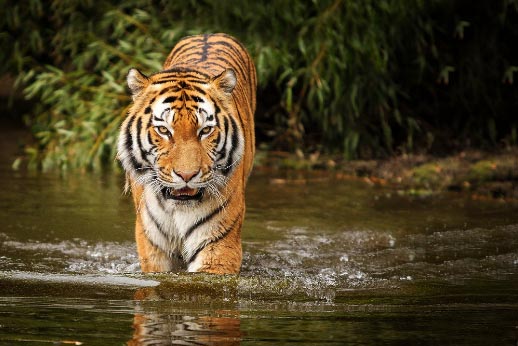Introduction: The Royal Bengal Tiger’s Sanctuary
The Sundarbans National Park is a land of mystery, dense mangrove forests, winding rivers, and one of the most iconic animals in the world — the Royal Bengal Tiger. Nestled in the heart of the Sundarbans, this park serves as a haven for these elusive, powerful creatures.
.jpeg)
Tigers in Sundarbans National Park not only symbolize the wild beauty of the region but also play a crucial role in maintaining the delicate ecosystem. This blog explores the Royal Bengal Tigers, their habitat, and the importance of conserving these magnificent creatures. We’ll also guide you on how you can see them up close in their natural home through responsible tourism.
Read More:
1. The Royal Bengal Tiger: A Symbol of Sundarbans National Park
The Royal Bengal Tiger is one of the most elusive and revered animals on the planet, and the Sundarbans National Park is one of the few places where you can witness these majestic creatures in the wild. This tiger subspecies, known for its distinctive orange coat and black stripes, is well adapted to life in the mangrove forests.

- Scientific Name: Panthera tigris tigris
- Size: Male tigers can weigh up to 500 pounds.
- Habitat: Mangrove swamps and tidal forests.
Despite their imposing size and strength, these tigers are often shy and avoid human interaction. Their stealth and agility are unmatched, making sightings a rare but exhilarating experience.
2. Why Are Tigers in the Sundarbans Unique?
Tigers in the Sundarbans have adapted to the unique landscape of the delta, which includes both land and water. This is why the Sundarbans tigers are often referred to as “swimming tigers”, as they are excellent swimmers and frequently cross rivers and creeks to hunt or explore their territory.
The dense mangroves provide perfect camouflage, helping them stalk prey, such as deer and wild boar. The tiger’s ability to swim long distances also enables it to navigate the waterways of the Sundarbans.

3. Tiger Conservation in Sundarbans National Park
Unfortunately, the Royal Bengal Tiger population has seen a significant decline due to habitat loss, poaching, and human-wildlife conflict. The Sundarbans National Park has been designated as a protected area to conserve this rare species.
Conservation efforts include:
- Anti-poaching laws: Protecting tigers from illegal hunting.
- Eco-tourism initiatives: Responsible tourism promotes tiger conservation and funds local protection efforts.
- Wildlife monitoring: Tracking and studying tiger populations for better management.
With ongoing conservation programs, the Sundarbans National Park remains one of the few places where the Royal Bengal Tiger population is relatively stable.

(External Reference: Wildlife Institute of India – Tiger Conservation)
4. Best Ways to Spot Tigers in Sundarbans National Park
While sightings of tigers in the wild are rare, there are a few ways to increase your chances of spotting one:
- Boat Safaris: The Sundarbans’ waterways are the best route to see tigers and other wildlife. Guided boat tours give you access to hard-to-reach places, where tigers roam freely.
- Early Morning Visits: Tigers are most active during early mornings or late afternoons, so plan your visit accordingly.
- Stay Quiet and Respectful: Always maintain a respectful distance, stay silent, and avoid sudden movements while on safari to avoid startling the tigers.
Booking a tour with Royal Sundarban Tourism ensures that your wildlife experience is not only safe but also helps contribute to ongoing conservation efforts.

5. The Ecological Importance of Tigers in the Sundarbans
Tigers play a key role in maintaining the balance of the Sundarbans ecosystem. As apex predators, they control the population of herbivores, preventing overgrazing of vegetation. This helps maintain the health of the entire ecosystem, from the mangrove trees to the aquatic life.
By protecting tigers, we’re also safeguarding the entire habitat they call home, which includes countless species of plants, animals, and birds.
:max_bytes(150000):strip_icc()/24852511_300908547067612_29037712277284310_n-5b8fa51d46e0fb00253b376a.jpg)
6. How to Visit Sundarbans National Park Responsibly
If you’re planning to visit the Sundarbans National Park to see tigers in their natural habitat, it’s important to be a responsible tourist. Here are some guidelines:
- Choose an eco-friendly operator: Opt for operators like Royal Sundarban Tourism, which follows sustainable practices.
- Avoid disturbing wildlife: Always follow your guide’s instructions to ensure the safety of both visitors and tigers.
- Support conservation programs: Your tour fees often go toward supporting wildlife protection and local communities.
Book Your Sundarbans Tiger Safari Today
Seeing tigers in Sundarbans National Park is a once-in-a-lifetime experience, and Royal Sundarban Tourism offers responsible and eco-friendly tours that guarantee a deeper connection with nature while supporting the preservation of these magnificent creatures.

You can book your Sundarban tiger safari with:
- Maity Tourism
- Sundarban Boat Tourism
All tours are powered by Argusdna.
Plan your adventure today and become part of a larger conservation effort while experiencing the Sundarbans’ Royal Bengal Tigers up close.
Conclusion: The Royal Bengal Tiger Awaits
The tigers in Sundarbans National Park embody the spirit of this mysterious land. Their strength, grace, and elusive nature have made them a symbol of the Sundarbans’ wild heart. By choosing eco-friendly tourism, you not only get to experience this iconic species but also contribute to its protection.
Embark on a journey to the Sundarbans and let the Royal Bengal Tiger captivate your imagination. Book your tour with Royal Sundarban Tourism today, and get ready to step into the world of one of Earth’s most majestic predators.

